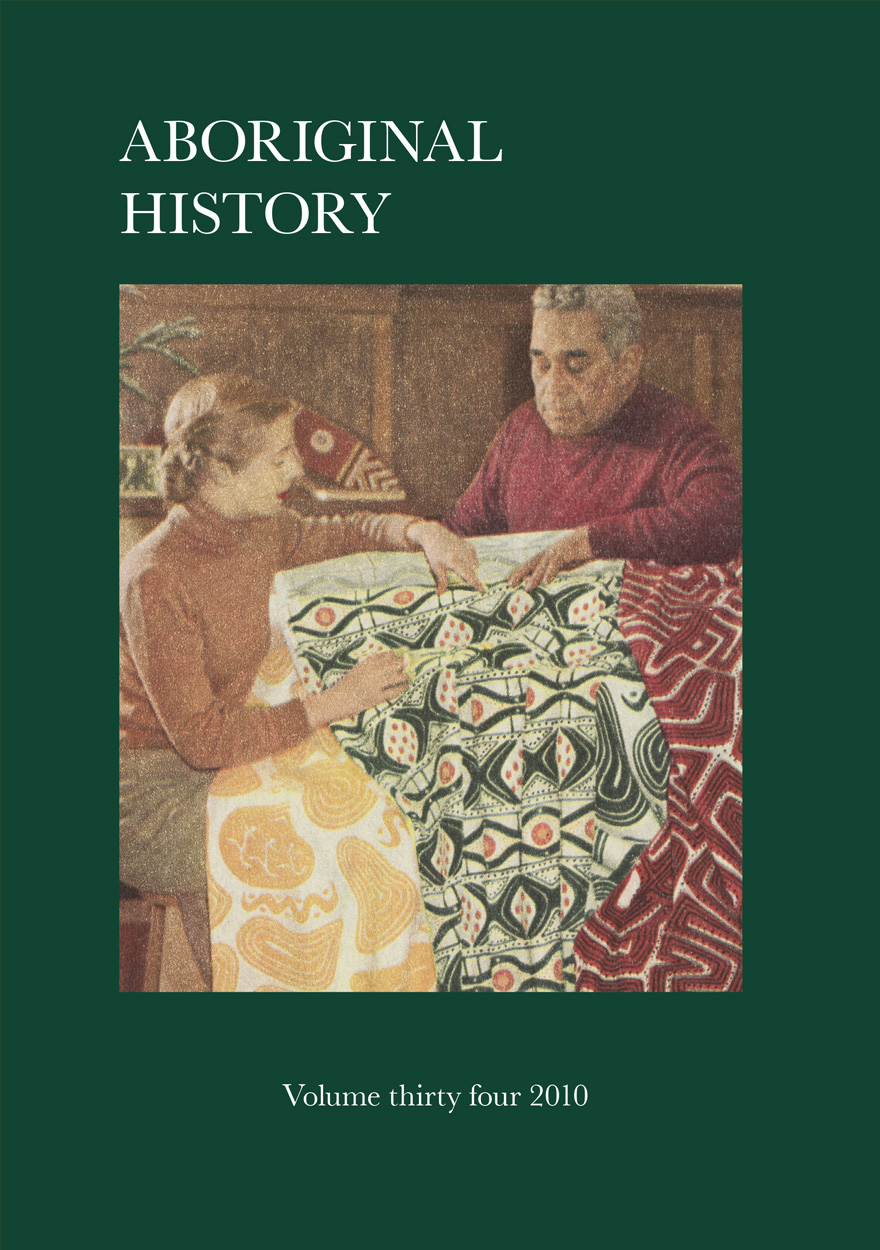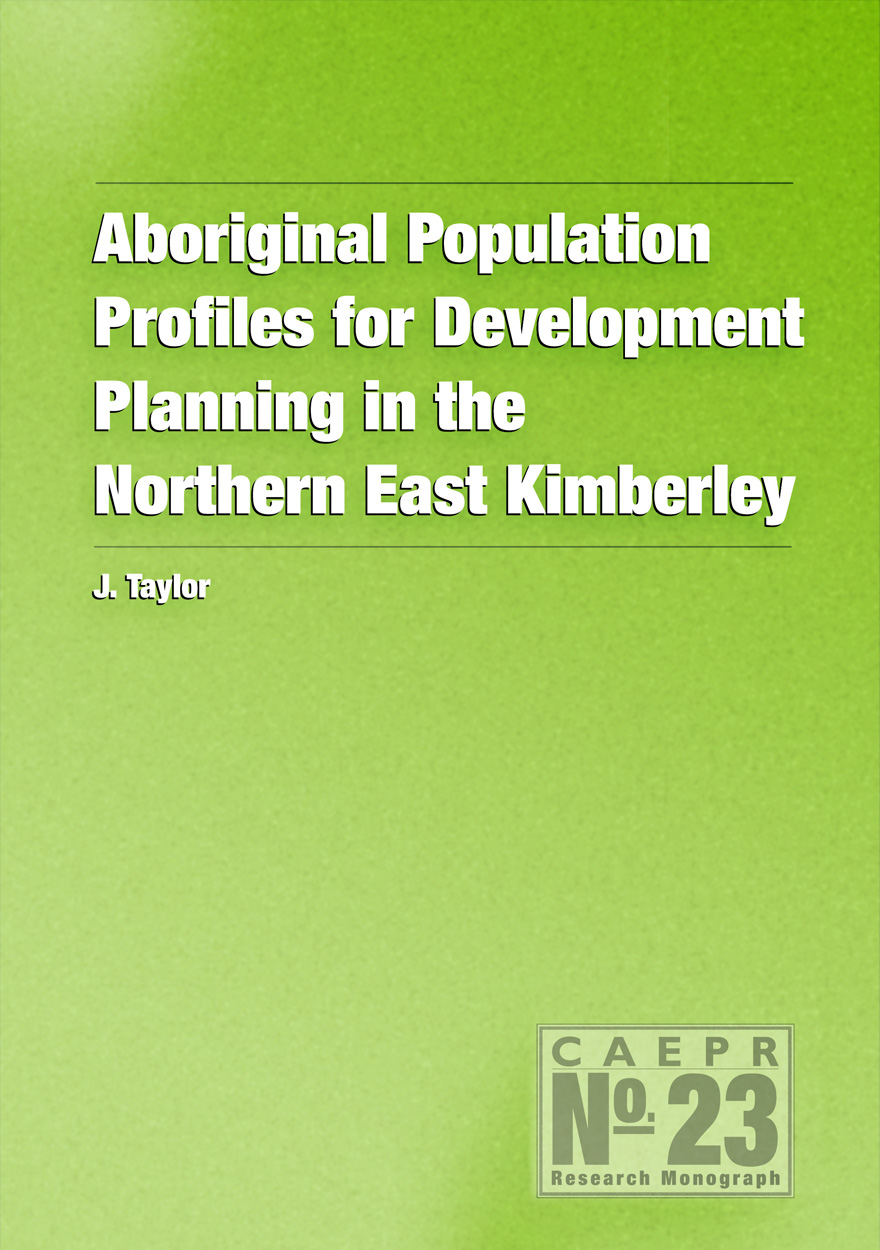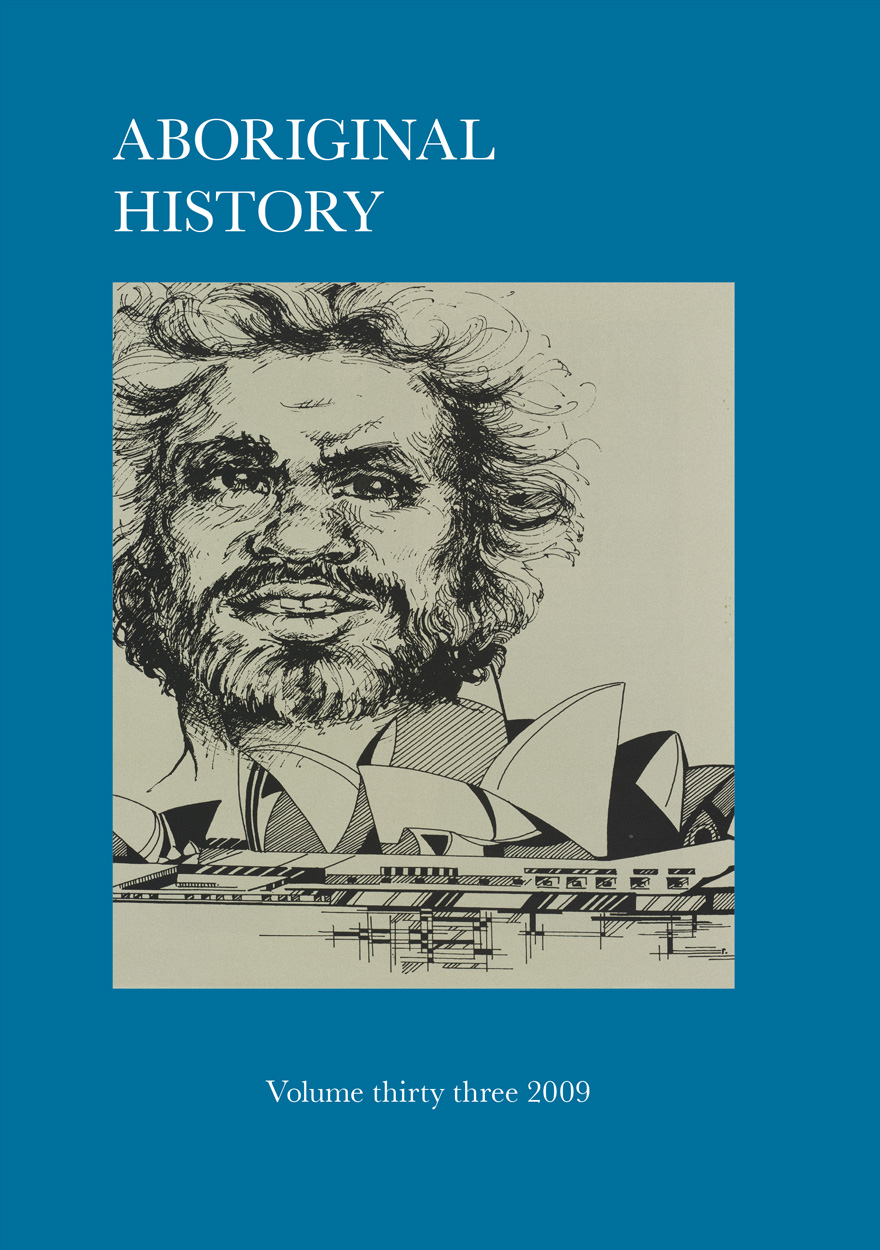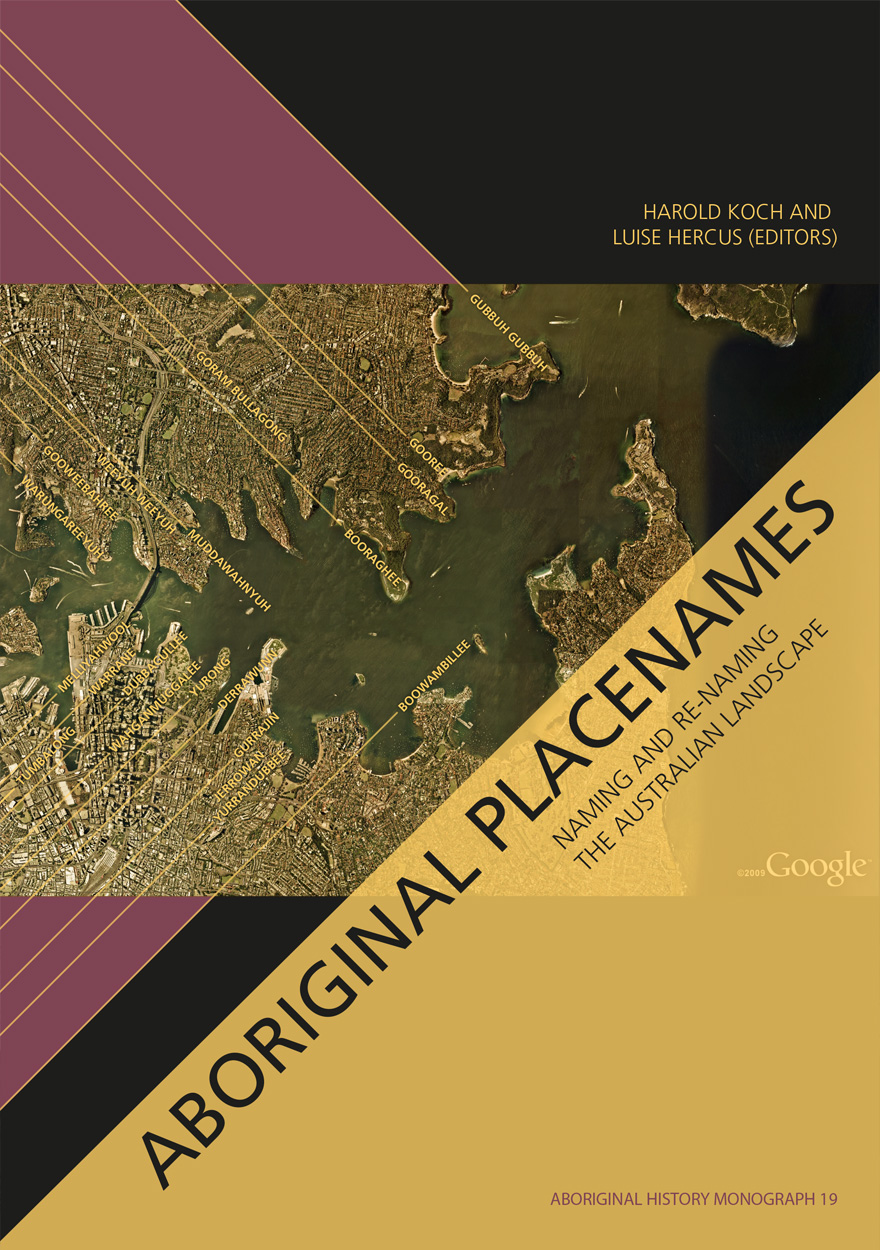Search titles
Displaying results 1 to 10 of 135.

Aboriginal History Journal: Volume 42 »
Edited by: Ingereth Macfarlane
Publication date: December 2018
In this volume, Peter Sutton provides a survey of the articles published by linguist Dr Luise Hercus (1926–2018) in Aboriginal History, honouring the contribution she has made to the journal since its inception. The seven articles this year highlight the wealth of sources that feed into historical research of Indigenous Australia. The role of performance in the events organised by the National Aborigines Day Observance Committee (NADOC) in 1957–67 in Sydney shows up the contest between state assimilationist goals and Indigenous participants’ insistence on distinction, continuity and survival (Jonathon Bollen and Anne Brewster). The then radical agenda – in a protectionist policy regime – of the advocacy group, the Aborigines’ Protection League in South Australia in the 1920s–30s, is examined in a detailed study of the group’s campaigns and campaigners (Rob Foster). A picture of colonial reception of Aboriginal performance and the public assertion of local Aboriginal cultural priorities in 1893 Darwin is developed in the historical contextualisation of a collection of Aboriginal artefacts found in the Marischal Museum, Aberdeen (Gaye Sculthorpe). A nuanced analysis of the relationship between the Catholic Benedictine Mission at New Norcia and the Western Australian Native Welfare Department draws on the correspondence between the Abbot of New Norcia and A.O. Neville (Elicia Taylor). A large body of reader responses to a recent online article on the deep history of Aboriginal Australia provides a way to map the strengths and weaknesses in the general Australian public’s apprehension of that long history (Lynette Russell and Billy Griffiths). A spatial history argues against the concept of ‘fringe camps’ and for a pattern of demonstrable continuities between precolonial, colonial and recent Aboriginal people’s favoured camp places and the locations of urban contemporary park spaces in Brisbane and townships in south-eastern Queensland (Ray Kerkhove). In the format of an interview, the themes concerning the writing of Aboriginal history and contemporary political debates that are developed in Tim Rowse’s recent book Indigenous and Other Australians since 1901 (2017) are explored (Miranda Johnson and Tim Rowse).
Aboriginal History Inc. is a publishing organisation based in the Australian Centre for Indigenous History, Research School of Social Sciences, The Australian National University, Canberra.
For more information on Aboriginal History Inc. please visit aboriginalhistory.org.au.
Download for free
Not available for purchase

Aboriginal History Journal: Volume 38 »
Edited by: Shino Konishi
Publication date: January 2015
Volume 38 features a special section on Western Australian Aboriginal history. Clint Bracknell translates and contextualises nineteenth-century Noongar songs. Amanda Nettelbeck considers the role of magistrates and justices of the peace in the ‘frontier legal networks’ of the Pilbara and Kimberley regions. Anne Scrimgeour traces the changing approach to the administration of Aboriginal people in the twentieth-century north-west through the biography of Laurie O’Neill, a former mounted policeman and travelling inspector. Craig Muller studies the history of the Wongatha of the north-east part of the Goldfields. Muller finds that Elkin’s account of his brief 1930 visit to the region was used as evidence in the recent Wongatha native title case without sufficient historical contextualisation. Together, the papers draw on rich archival sources, complicate our understandings of the way in which Aboriginal lives were controlled in the past, and highlight Aboriginal voices and perspectives.
The other four articles exploring Aboriginal histories from other parts of Australia. Nicholas Brodie reconstructs the life of Dalrymple Briggs, a Vandemonian woman of mixed-descent. Noah Riseman examines the lives of three Aboriginal servicemen who all had media profiles as successful examples of assimilation. The other two articles examine different non-Indigenous accounts of Aboriginal people and culture. Marguerita Stephens critically examines discourses on Aboriginal infanticide in colonial Victoria. The history of tourist visits to Palm Island, an Aboriginal reserve in Queensland is the focus of Toby Martin’s article.
Aboriginal History Inc. is a publishing organisation based in the Australian Centre for Indigenous History, Research School of Social Sciences, The Australian National University, Canberra.
For more information on Aboriginal History Inc. please visit aboriginalhistory.org.au.
Download for free
Not available for purchase

Aboriginal History Journal: Volume 40 »
Edited by: Liz Conor
Publication date: December 2016
In this volume, Katharine Booth and Lisa Ford present the details of a watershed Northern Territory legal decision. Angela Lapham challenges our understanding of the term ‘assimilation’ in her study of Stanley Middleton. Charmaine Robson looks at Australian leprosy control policy in the twentieth century. The ‘entanglements’ of Aboriginal and European people within farming and pastoral industries on Yorke Peninsula (Guuranda), South Australia, are recorded by Belinda Liebelt, Amy Roberts, Clem O’Loughlin and Doug Milera. The positive memories of Aboriginal residents on missions are interrogated by Laura Rademaker. She sifts through their petitions to mission authorities in the 1960s, uncovering the rare instances of Aboriginal voices asserted within the missionary archives. In a collaborative article, Heather Burke, Amy Roberts, Mick Morrison, Vanessa Sullivan and the River Murray and Mallee Aboriginal Corporation (RMMAC) investigate Aboriginal–European early contact on the western Central Murray. Adopting a landscape perspective, they visualise the sociospatial processes of violent engagement that occurred between Aboriginal and European people along the Overland Stock Route. Archibald Meston, Southern Protector of Queensland Aborigines from 1898 to 1904, is brought to life by Judith McKay and Paul Memmott. Meston was the major architect of Queensland’s 1897 Aboriginals Protection and Restriction of the Sale of Opium Act. Meston’s venture as a showman of live Indigenous people, who he publicly paraded as ‘noble savages’, is shown to have shaped his policies and informed this influential legislation. In 1838, French Captain Abel du Petit-Thouars recorded his impressions of Australia. Colin Dyer provides a translation of the captain’s journal, providing a new resource in English for researchers.
Aboriginal History Inc. is a publishing organisation based in the Australian Centre for Indigenous History, Research School of Social Sciences, The Australian National University, Canberra.
For more information on Aboriginal History Inc. please visit aboriginalhistory.org.au.
Download for free
Not available for purchase

Aboriginal History Journal: Volume 34 »
Edited by: Shino Konishi, Maria Nugent
Publication date: January 2011
In this volume, Mitchell Rolls reconsiders the question of silence in Aboriginal history by examining a wide range of literature on Indigenous themes, which was produced during the period dubbed by W.E.H. Stanner as the ‘Great Australian Silence’. Felicity Jensz uncovers the significance of matrimony in Moravian missionaries’ attempts to Christianise Aboriginal people in the nineteenth century, and Anne McGrath traces the history and continuing legacy of relationships between Aboriginal and Irish people in Australia. Meg Parsons’ study is focused on Sir Raphael Cilento, an often overlooked figure who oversaw Queensland’s Aboriginal leprosy management strategies in the 1930s and the establishment of the Fantome Island leprosarium. Pamela McGrath and David Brooks examine William Grayden’s 1957 film Their Darkest Hour, and how it was interpreted by contemporary audiences, Indigenous activists and, finally, the Ngaanyatjarra people’s perceptions of the film now. Martin Thomas looks at the 1948 American–Australian Scientific Expedition to Arnhem Land, the Indigenous response to it and its continuing legacy. Sylvia Kleinert discusses the little-known history of Bill Onus’s Aboriginal Enterprises, a tourist outlet that fostered an influential Indigenous art scene in Melbourne and its impact on Aboriginal identity formation in south-eastern Australia. Jessie Mitchell examines questions of Aboriginal cultural performance in her study of the Aboriginal reception of Prince Alfred’s 1868 royal tour. Finally, Petter Naessan gives a rich linguistic history of the name Coober Pedy, evaluating a range of sources each claiming different Indigenous etymological origins of the name.
Aboriginal History Inc. is a publishing organisation based in the Australian Centre for Indigenous History, Research School of Social Sciences, The Australian National University, Canberra.
For more information on Aboriginal History Inc. please visit aboriginalhistory.org.au.
Download for free
Not available for purchase

Aboriginal History Journal: Volume 39 »
Edited by: Liz Conor
Publication date: December 2015
Volume 39 presents a special section on Aboriginal war service, edited by Allison Cadzow, Kristyn Harman and Noah Riseman. The contributors reappraise narratives and foster new avenues of inquiry, particularly on the impact of war service on families and communities, and explore how the entrance of Aboriginal men into Australian military service disrupted accustomed notions of defence of country. John Maynard extends this service back to the South African Anglo-Boer War. Andrea Gerrard and Kristyn Harman track the aftermath of the First World War for Tasmanian soldiers of Aboriginal descent. Philippa Scarlett challenges the ‘mateship myth’ of the Australian Imperial Force (AIF) of the First World War. The denial of repatriation benefits fuelled Aboriginal people’s post-war disenchantment and the political agitation of the 1920s and 1930s, as Jessica Horton shows. She finds it was demand for land exacerbated by the Soldier Settlement Scheme that precipitated the closure of reserves, creating a new ‘home front’ for Gunditjmara veterans resisting ongoing dispossession. Kristyn Harman looks at correspondence between white women and Aboriginal soldiers during the Second World War as overseen by the Aborigines Uplift Society’s national comforts auxiliary.
In the other articles in this volume, Sharon Delmege investigates policy implementation at Allawah Grove Native Settlement (1957–69). Anne O’Brien focuses on provisioning at Ernabella mission, South Australia in 1937. Steven Anderson looks at Indigenous executions in colonial South Australia, where public hangings were reintroduced, but only for Indigenous capital offenders. Greg Blyton casts light on the little-known story of Harry Brown, guide to Ludwig Leichhardt on two expeditions into the interior. Robin Barrington provides a corrective to the colonial visual archive in her examination of public constructions of Yamaji individuals by Daisy Bates and Alexander Morton.
Aboriginal History Inc. is a publishing organisation based in the Australian Centre for Indigenous History, Research School of Social Sciences, The Australian National University, Canberra.
For more information on Aboriginal History Inc. please visit aboriginalhistory.org.au.
Download for free
Not available for purchase

Aboriginal Population Profiles for Development Planning in the Northern East Kimberley »
Authored by: John Taylor
Publication date: March 2004
John Taylor is a Senior Fellow at the Centre for Aboriginal Economic Policy Research, The Australian National University, Canberra.
The Northern East Kimberley region of Western Australia is poised at a development crossroads with decisions pending on the extension or closure of Argyle Diamond Mine, and the ever-present prospect of agricultural expansion based on Ord Stage II. This region also has a major economic development problem—half of its adult population (almost all Aboriginal) is highly dependent on welfare, mostly outside the mainstream labour market, and ill-equipped to engage it.
Aboriginal people are major stakeholders in the region as its customary owners and most permanent residents. Whatever decisions are made about future development, it is essential that they bring about improvements in Aboriginal participation, not least because of the high opportunity cost to Aboriginal people and to government of failing to do so.
This study profiles social and economic conditions in the region, focusing on the Aboriginal population. It examines demography, the labour market, income, education and training, housing and infrastructure, health status, and regional involvement in the criminal justice system. It provides a quantum to discussions of need, aspirations and regional development capacities, as well as a benchmark against which the impact of developmental actions may be assessed.

The Contest for Aboriginal Souls »
European missionary agendas in Australia
Authored by: Regina Ganter
Publication date: May 2018
This book covers the missionary activity in Australia conducted by non-English speaking missionaries from Catholic and Protestant mission societies from its beginnings to the end of the mission era. It looks through the eyes of the missionaries and their helpers, as well as incorporating Indigenous perspectives and offering a balanced assessment of missionary endeavour in Australia, attuned to the controversies that surround mission history. It means neither to condemn nor praise, but rather to understand the various responses of Indigenous communities, the intentions of missionaries, the agendas of the mission societies and the many tensions besetting the mission endeavour. It explores a common commitment to the supernatural and the role of intermediaries like local diplomats and evangelists from the Pacific Islands and Philippines, and emphasises the strong role played by non-English speakers in the transcultural Australian mission effort.
This book is a companion to the website German Missionaries in Australia – A web-directory of intercultural encounters. The web-directory provides detailed accounts of Australian missions staffed with German speakers. The book reads laterally across the different missions and produces a completely different type of knowledge about missions. The book and its accompanying website are based on a decade of research ranging across mission archives with foreign-language sources that have not previously been accessed for a historiography of Australian missions.
‘A remarkable intellectual achievement, compelling reading.’
— Dr Niel Gunson
‘The range of knowledge on display here is very impressive indeed.’
— Professor Peter Monteath

Aboriginal History Journal: Volume 35 »
Edited by: Shino Konishi, Maria Nugent
Publication date: November 2011
In this volume, Grace Karskens extends her cross-cultural research on early colonial New South Wales by focusing on the uses of European clothing by Aboriginal men. Leah Lui-Chivizhe describes the participation of Torres Strait Islander men in railway construction work in Western Australia. Noah Riseman focuses on the life of one man to explore the experience of institutionalisation as a member of the Stolen Generations and later as a member of the Australian armed forces. Both these articles reflect on the nature of personal and collective remembrance, the ethics of using oral testimony in writing Indigenous history, and the relationship between oral and archival evidence. Ian D. Clark’s article answers Michael Connor’s refutation of the ‘Convincing Ground’ massacre and gives his own interpretations and conclusions regarding the evidence.
Christine Choo and Peta Stephenson, leaders of research into Aboriginal–Asian relations, have edited a special section on this topic, 30 years after James Urry’s Aboriginal History 1981 volume 5 on the same theme. They note in their introduction that the four papers together ‘retrieve pre-colonial and colonial relationships that place white settler narratives of Australia’s social development in a wider perspective. In the process, they challenge the ideological foreclosures and sometimes methodological timidity of mainstream nationalist histories’. Campbell Macknight published a piece in the 1981 volume on his research into contact between Macassans and Aboriginal people in Arnhem Land; in this volume, he reflects on the development of his own scholarship and on research in this area. Anna Shnukal did not contribute a piece to the 1981 volume, but in 1985 (Volume 9) she published an article on Torres Strait Islander creole. Her contribution this time focuses on Filipinos in the outer Torres Strait islands and the families they established with Indigenous women. Marriage is also the theme in Julia Martínez’s article, exploring marriages between Indonesian men and Indigenous Australian women. Victoria Haskins documents one Chinese family’s efforts to be allowed to employ Aboriginal workers in the early twentieth century.
Aboriginal History Inc. is a publishing organisation based in the Australian Centre for Indigenous History, Research School of Social Sciences, The Australian National University, Canberra.
For more information on Aboriginal History Inc. please visit aboriginalhistory.org.au.
Download for free
Not available for purchase

Aboriginal History Journal: Volume 33 »
Edited by: Peter Read
Publication date: April 2010
In her recent magisterial history of early Sydney, Grace Karskens mused on a critical distinction in emphasis between settler history and Aboriginal history: ‘in settler history we seem to be searching constantly for beginnings’, she notes, ‘but in Aboriginal history in the colonial period so often the search is for endings’. This preoccupation with endings especially haunts the ‘storywork’ surrounding Woollarawarre Bennelong, one of the best known but least understood Aboriginal men of the early colonial era. Most of this storywork has figured Bennelong as a tragic soul – caught between two worlds, reconciled to neither, the victim of an addiction that was his only means of enduring the fall. Despite some variations in the telling of his life with the British colonists, the tragedy of his end usually dominates the overall tone.
A reconsideration of one of the most significant Aboriginal figures in colonial history invites us to move away from the search for endings. It suggests a fresh start for the life of Bennelong. It also suggests a fresh start for the meaning of Bennelong in Australia’s modern imagination. If Bennelong’s life stands for any greater truth, it is that indigenous people begin new relations when history demands them as frequently and as variously as any other folk.
Aboriginal History Inc. is a publishing organisation based in the Australian Centre for Indigenous History, Research School of Social Sciences, The Australian National University, Canberra.
For more information on Aboriginal History Inc. please visit aboriginalhistory.org.au.
Download for free
Not available for purchase

Aboriginal Placenames »
Naming and re-naming the Australian landscape
Edited by: Harold Koch, Luise Hercus
Publication date: October 2009
Aboriginal approaches to the naming of places across Australia differ radically from the official introduced Anglo-Australian system. However, many of these earlier names have been incorporated into contemporary nomenclature, with considerable reinterpretations of their function and form. Recently, state jurisdictions have encouraged the adoption of a greater number of Indigenous names, sometimes alongside the accepted Anglo-Australian terms, around Sydney Harbour, for example. In some cases, the use of an introduced name, such as Gove, has been contested by local Indigenous people.
The 19 studies brought together in this book present an overview of current issues involving Indigenous placenames across the whole of Australia, drawing on the disciplines of geography, linguistics, history, and anthropology. They include meticulous studies of historical records, and perspectives stemming from contemporary Indigenous communities. The book includes a wealth of documentary information on some 400 specific placenames, including those of Sydney Harbour, the Blue Mountains, Canberra, western Victoria, the Lake Eyre district, the Victoria River District, and southwestern Cape York Peninsula.
For more information on Aboriginal History Inc. please visit aboriginalhistory.org.au.



